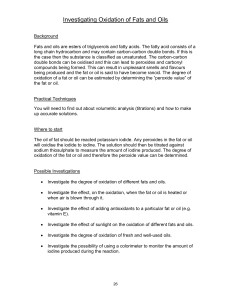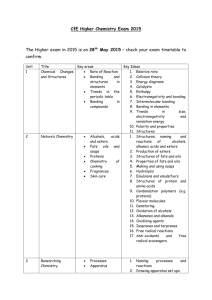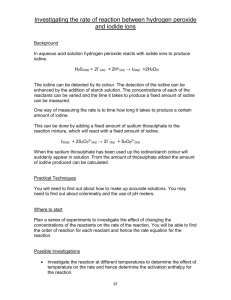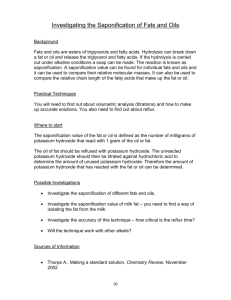Investigation unsaturation of fats and oils
advertisement
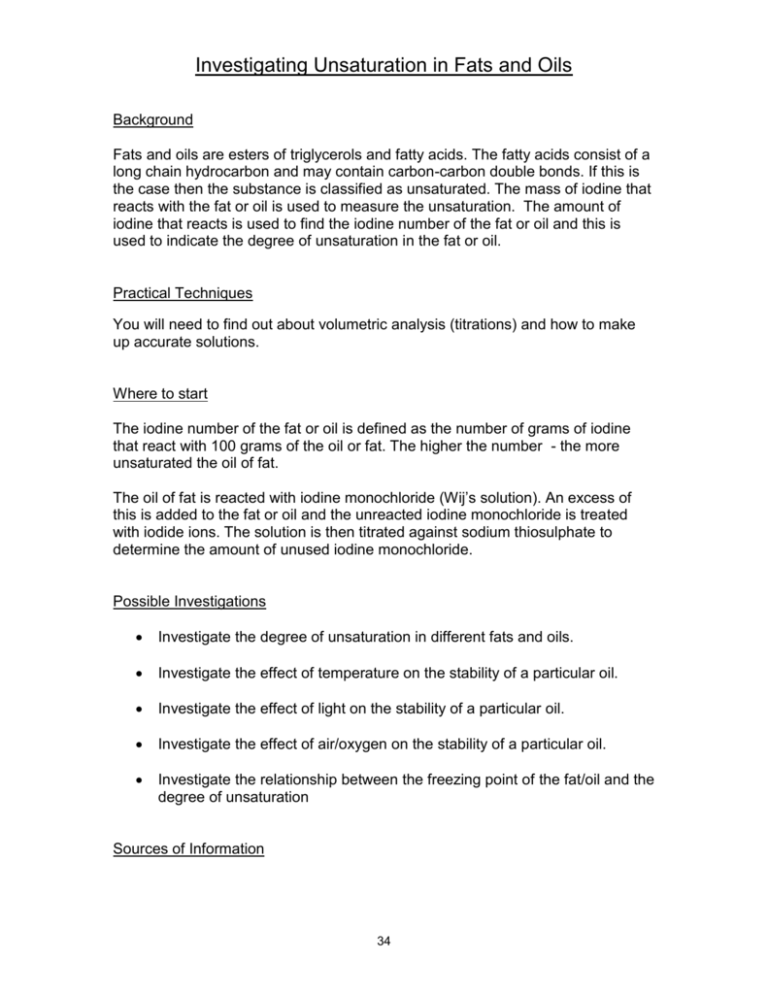
Investigating Unsaturation in Fats and Oils Background Fats and oils are esters of triglycerols and fatty acids. The fatty acids consist of a long chain hydrocarbon and may contain carbon-carbon double bonds. If this is the case then the substance is classified as unsaturated. The mass of iodine that reacts with the fat or oil is used to measure the unsaturation. The amount of iodine that reacts is used to find the iodine number of the fat or oil and this is used to indicate the degree of unsaturation in the fat or oil. Practical Techniques You will need to find out about volumetric analysis (titrations) and how to make up accurate solutions. Where to start The iodine number of the fat or oil is defined as the number of grams of iodine that react with 100 grams of the oil or fat. The higher the number - the more unsaturated the oil of fat. The oil of fat is reacted with iodine monochloride (Wij’s solution). An excess of this is added to the fat or oil and the unreacted iodine monochloride is treated with iodide ions. The solution is then titrated against sodium thiosulphate to determine the amount of unused iodine monochloride. Possible Investigations Investigate the degree of unsaturation in different fats and oils. Investigate the effect of temperature on the stability of a particular oil. Investigate the effect of light on the stability of a particular oil. Investigate the effect of air/oxygen on the stability of a particular oil. Investigate the relationship between the freezing point of the fat/oil and the degree of unsaturation Sources of Information 34 Thorpe A., Making a standard solution, Chemistry Review, November 2002 Battye P., Titrations, Chemistry Review, February 2003 Selinger B., (1998), Chemistry in the Marketplace, Harcourt, Brace, Jovanovich, London Shipton M., Fats and Oils, Unilever Educational Booklet: Advanced Series Robertson K.J.A., Gray C., Wood, C.A. (2001) Starter Investigations for Advanced Higher Chemistry, Royal Society of Chemistry The Chemistry Video Consortium and The Royal Society of Chemistry (2000) Practical Chemistry for Schools and Colleges CD ROM Ferguson M., Volumetric Analysis. Chemistry Review, September 1996 Thorpe A., Assessing the risks in practical work, Chemistry Review, September 2000 Thorpe A., Experimental error and error analysis: just how good are those results, Chemistry Review, November 2001 http://www.chem.pacificu.edu/GenChemProjects/pages Faust C.B., Jassal S.S., (1993) Lipids – a consumer’s guide, Education in Chemistry, Vol 30,1 35 Teachers' Notes General The Fats and Oils booklet by Unilever is an excellent source for this investigation and has full details of this experiment. Each titration experiment can take up to 1 hour. Chemical Principles Fats and oils, alkenes, esters, quantitative chemistry Essential Equipment Burettes, pipettes Essential Chemicals Starch, potassium iodide, sodium thiosulphate, Wij’s solution (or chemicals to prepare this) Safety No risk assessment has been given. It is essential that students prepare a detailed risk assessment before they start. Teachers must be satisfied that this is suitable for the proposed investigation. 36 Experiment Starter Sheet – Investigation unsaturation of fats and oils A basic procedure is given below. Prepare the following solutions starch solution 10% potassium iodide solution 0.1 mol dm-3 sodium thiosulphate solution Wij’s Solution - you can purchase this or you can look up a recipe for its preparation. One example of a recipe is to dissolve 2 grams of diiodine hexachloride in 50cm3 of glacial ethanoic acid and stir in a solution of 2.25 grams of iodine in glacial ethanoic acid. Then dilute to 250 cm 3 with the ethanoic acid. Heat on a water bath for 15 minutes, stir regularly and allow to cool. You may also be able to find other method of preparing Wij’s solution. You will need to think about how much of each solution to prepare. This will depend on how much of the solution is used in each experiment and how many experiments you do (including any repeats). Weigh out about 0.2 grams of the fat or oil in a dry 250 cm 3 stoppered bottle. Add 10 cm3 of the Wij’s solution and mix by swirling the flask. Set up a blank mixture by omitting the fat or oil. Leave both flasks in the dark for about 30 minutes. Then add 15cm3 of 10% potassium iodide solution and 10cm3 of water to each flask and mix thoroughly. Titrate the contents with sodium thiosulphate solution using starch solution as an indicator, just before the end point. 37
